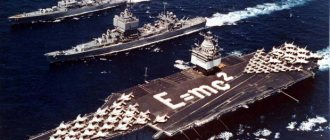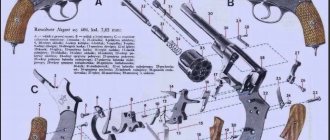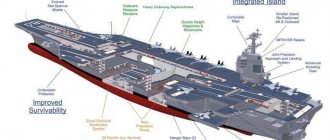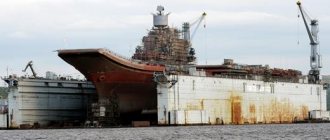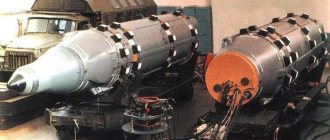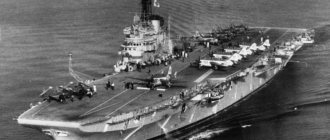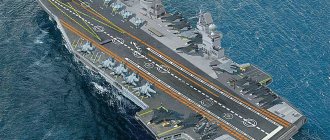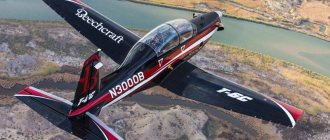For more than half a century, aircraft carriers have been the backbone of US naval power. No other naval power has so many of these floating airfields in its fleet, and not a single aircraft carrier of another country can compare with them in size. The oldest aircraft-carrying ship in service now is the Nimitz, and most of the others were built to a similar design.
For more than forty years, ships of the Nimitz class have been the strongest American aircraft carriers, and the new Gerald Ford class is essentially a further development of its predecessors. But the lead ship of the series, named after the outstanding admiral, will not retire soon.
Creation and device
The history of American super-heavy aircraft carriers began shortly after World War II. Already in 1951, the first of them, Forrestal, was laid down. The four ships of this project differed from previous designs not only in their size and the size of the air group.
During their construction, for example, an angular flight deck and steam catapults were used for the first time. And in 1958, construction began on the first nuclear-powered aircraft carrier, the Enterprise. It was supposed to be the flagship in the series, but the high cost forced us to abandon the construction of “sisterships”. But not for long, ten years later, a new nuclear-powered aircraft carrier was laid down, named after Fleet Admiral Chester Nimitz.
Externally, the Nimitz was almost no different from the previous series of ships of the Kitty Hawk type.
But during its construction, they took into account the experience of combat operation of aircraft carriers in Vietnam. Practice has shown that the ability to effectively support the actions of an air group is more important than increased survivability, so the reserves of aviation fuel and weapons were significantly increased.
However, this was also helped by the significant difference between the Nimitz and the Enterprise - eight A2W reactors were replaced by two A4W, which took up less space with the same total power. The steam produced by the two reactors is transferred to four turbines that rotate four shafts. The ship's four bronze propellers have a diameter of 7.6 m each.
Like its predecessors, the Nimitz has four steam catapults on its flight deck. Braking of landing aircraft is provided by four aerofinisher cables. Three aircraft lifts are located on the starboard side, one on the left. The “island” superstructure is located between the second and third lifts. A similar scheme has proven itself well on the Kitty Hawk ships. In 1983, the Nimitz received 64 mm thick Kevlar armor.
Protection measures
Since most aircraft on board are equipped with jet engines, in order to protect the people working on the ship and the equipment and weapons located there from the action of gas jets, special reflectors are provided on the deck. At the same time, to ensure that the deck surface, which is under the almost constant influence of various technical means and tools, does not overheat, special deck panels are made that are cooled naturally as a result of the continuous exposure to water coming directly from overboard.
In order to provide greater stability to the flight deck, which must withstand the enormous weight of fighters and related equipment (especially in the lateral areas hanging over the water), the aircraft carrier is equipped with a special gallery deck. On some ships, in the space that remains under it, an additional hangar with two-layer protection is equipped.
In addition, personnel quarters and most of the command quarters are located on this deck. Access to the upper deck is provided by bypass bridges. In addition, the military can, without rising from the gallery deck to the upper deck, move along the front of the ship from bow to stern along a special through passage.
The remaining decks contain special mechanisms that allow fighters to be moved for a more rational distribution of spaces. In addition, officers' quarters and doctors' offices are also located here. There are also personnel canteens here, which, if necessary, can be immediately converted into aviation ammunition assembly areas.
The hold is equipped with cellars used for storing ammunition, tanks with fuel for aviation equipment and storerooms for various purposes. In addition, freezers and refrigeration chambers for storing food are also located here, thanks to which the crew can be on the open sea for a long time without experiencing any special difficulties.
Armament
The Nimitz's own weapons are limited to air defense systems. Initially, it consisted of three or four launchers of short-range RIM-7 Sea Sparrow anti-aircraft missiles and Phalanx 20mm anti-aircraft guns. After modernization, the old weapons were supplemented (and partially replaced) with RIM-116 anti-aircraft missiles.
For self-defense there are turrets with heavy machine guns and 25mm guns.
Electronic weapons include jammers and launchers of infrared decoys and dipole reflectors (for protection against heat- and radar-guided missiles).
The main protection of an aircraft carrier is provided by the ships of the strike group, which may include cruisers and submarines. In 2013, the Nimitz escort group consisted of six Arleigh Burke-class destroyers and a Ticonderoga-class cruiser.
Currently, the 11th carrier-based air wing, consisting of nine squadrons, is assigned to the Nimitz:
- The 146th and 147th Attack Squadrons are armed with F/A-18E aircraft;
- 154th - its two-seat version F/A-18F;
- the wing's 323rd Marine Corps Squadron flies an earlier modification of the F/A-18C;
- The 142nd Electronic Warfare Squadron operates EA-18 aircraft;
- E-2 aircraft are used for long-range radar detection;
- logistics tasks are solved by light transports C-2;
- two helicopter squadrons are armed with MH-60 helicopters.
Among the aircraft based at Nimitz in the past were F-14 fighters, A-7 and A-6 attack aircraft, and S-3 anti-submarine aircraft.
Basic data
The Nimitz aircraft carriers, with a total ammunition mass of 1,954 tons, are considered one of the most powerful warships in the world.
The main armament of these ships is carrier-based aircraft consisting of fighters, helicopters and military aircraft, thanks to which the aircraft carrier can easily cope with such tasks as:
- electronic warfare;
- detection of the enemy at a significant distance;
- transportation.
Moreover, if an aircraft carrier is attacked at a time when all air equipment is involved in carrying out any operation, it can easily repel the attack with its own anti-aircraft, missile and artillery systems installed on board.
In essence, Nimitz-class aircraft carriers compare favorably with other warships. For example, their hull is made entirely of steel sheets, and all key elements, including the deck used for flights, are made of armored steel.
At the same time, the structure of the ship is designed in such a way that it not only improves the performance characteristics, but also allows for a more rational placement of the engine and steering complex.
Service history
The Nimitz entered service in May 1975, and already in July of the following year it went on its first voyage to the Mediterranean Sea. This trip, like the subsequent ones, passed without incident, and during the third, at the end of 1979, the Nimitz was transferred to the Indian Ocean. To free the American hostages in Iran, special forces were to be sent from the aircraft carrier. The operation failed and the ship returned to the United States.
In 1981, American ships, including the Nimitz, conducted exercises in the Gulf of Sidra, declared Libyan territorial waters by Muammar Gaddafi. During the exercise, two Libyan fighter jets unexpectedly fired a missile at approaching American F-14s. In response, both Libyans were shot down. The American fighters belonged to the Nimitz air wing.
During 1985, the ship was off the coast of Lebanon, and its planes bombed Beirut. After her sixth voyage to the Mediterranean in 1986, the Nimitz sailed around Cape Horn to join the Pacific Fleet. In October 1988, he ensured the safety of tankers in the Arabian Sea.
In the early 90s he made military campaigns in the Persian Gulf, but did not take direct part in the war with Iraq.
From 1998 to 2001 it was undergoing maintenance, which included recharging the reactors. Since 2003, he took part in operations against Iraq and Afghanistan. In 2022, aircraft from the aircraft carrier attacked targets in Syria. Since March 2022, the Nimitz has been in dry dock for regular maintenance.
Features of the control system of the US Aircraft Carrier
The Nimitz is equipped with a large number of innovative systems that allow it to control military equipment with virtually no human intervention. For example, to land an airplane in poor visibility, when the pilot cannot see the landing strip, an automatic landing system called ACLS is used.
As soon as visibility begins to be less than 1000 m, the system independently requests and processes all data on flight parameters from the TACAN air navigation system and other aircraft devices, encodes the information and sends signals appropriate to the situation to the on-board autopilot. After which the plane is automatically launched exactly onto the corner deck of the aircraft carrier without the participation of the pilot in the landing process.
Characteristics of the ship in comparison with other aircraft carriers
To say that the Nimitz had no analogues would not be an exaggeration. He really didn't have any. Great Britain did not build heavy aircraft carriers after the war. Most other states with aircraft-carrying ships in their navies used modernized wartime aircraft carriers sold to them.
Comparisons can only be made to demonstrate the superiority of the Nimitz. For example, let’s take the then modern French “Clemenceau” and the newest (in the seventies) British “Invincible”
| "Nimitz" | "Clemenceau" | "Invincible" | |
| Length, m | 332 | 265 | 209 |
| Displacement, t | 101600 | 32780 | 22000 |
| Cruising range, km | unlimited | 12070 | 13000 |
| Travel speed, knots | 30 | 32 | 28 |
| Armament | RIM-7 SAM, 3 x 20 m anti-aircraft artillery mounts | 4 x 100mm artillery mounts, 2x8 Krotal air defense missile launchers | 3 x 30mm anti-aircraft artillery mounts, 2 x 20mm cannons |
| Air group | Up to 90 aircraft | Up to 40 aircraft | 18 airplanes, 4 helicopters |
It is noticeable that “Clemenceau”, being a “real” aircraft carrier, in terms of the size and power of the air squad, is more likely to be modernized American ships from the Second World War (such as “Midway”), and would not stand comparison with “Forrestal”. As for the Invincible, with a small number of vertical take-off aircraft, it would be appropriate to compare it with Soviet aircraft-carrying cruisers, which carried much more of their own weapons.
But that was in the seventies, so what now? The French fleet now has its own nuclear-powered aircraft carrier, the Charles de Gaulle. But it is only slightly larger than the Clemenceau, and the size of the air group remained at the same level - up to four dozen. Britain's newest ship, Queen Elizabeth, is expected to carry 36 F-35 aircraft. The American standard remains unattainable.
As for the Russian aircraft carrier Admiral Kuznetsov, it, inferior to the Nimitz in terms of air group power, had powerful missile weapons. But Kuznetsov is undergoing modernization, which can greatly change its characteristics.
Composition of the air group
In addition to the installed defensive weapons, the main and formidable weapon of such a giant is the air wing. But it is worth considering the fact that the ship carries not only combat aircraft, but also support and cover aircraft. The most common air group composition for a Nimitz-class vessel consists of fighters, Hornet-class fighter-bombers, Pauler-class electronic warfare aircraft, Hawkeye-class aircraft, transport aircraft, anti-submarine helicopters, as well as Sea rescue helicopters. Hawk." In total, the number of aircraft at maximum load is 90 units, but an acceptable amount is about 65 units.
Hornet fighter-bombers
Crew size
The number of crew is approximately the same on all ships of the Nimitz type, only the USS John C. Stennis (CVN-74) has a slightly smaller crew. The number of crew on it, together with the air wing crew, is 5617 people. The Nimitz has a crew size of 3,200 and an air wing number of 2,480.
Interesting Facts
Already in 1980, Nimitz became the hero of the science fiction film Countdown. In it, the ship, leaving Pearl Harbor, traveled through time, ending up on the eve of the Japanese attack. In 2004, F/A-18 pilots from the Nimitz observed unidentified flying objects. In 2008, Russian Tu-95 bombers flew over an aircraft carrier, simulating an attack.
The planned service life of Nimitz aircraft carriers is about fifty years.
The lead ship was supposed to be decommissioned back in 2022, when the aircraft carrier John F. Kennedy, which is under construction, was commissioned, but at the end of 2021, the Nimitz is successfully on combat duty.
If dismantling the reactors does not require dismantling, as in the case of the Enterprise, most of the hull, then there is a possibility that the Nimitz could be turned into a museum ship. This would be a more than fitting end to his service.

